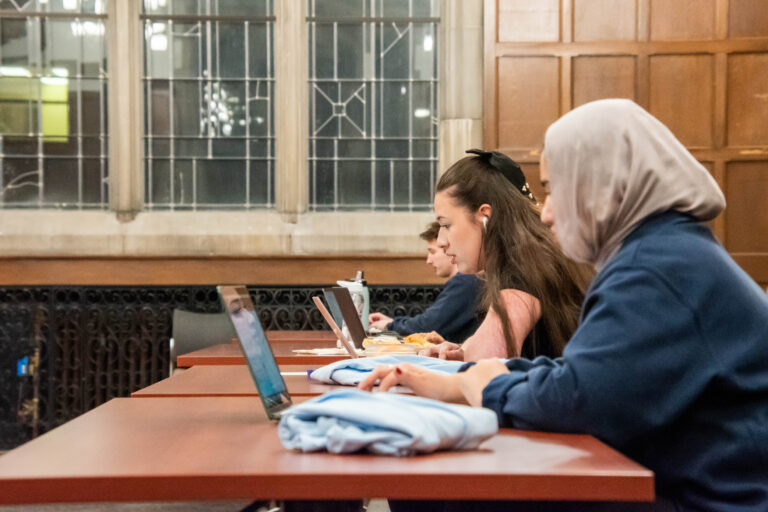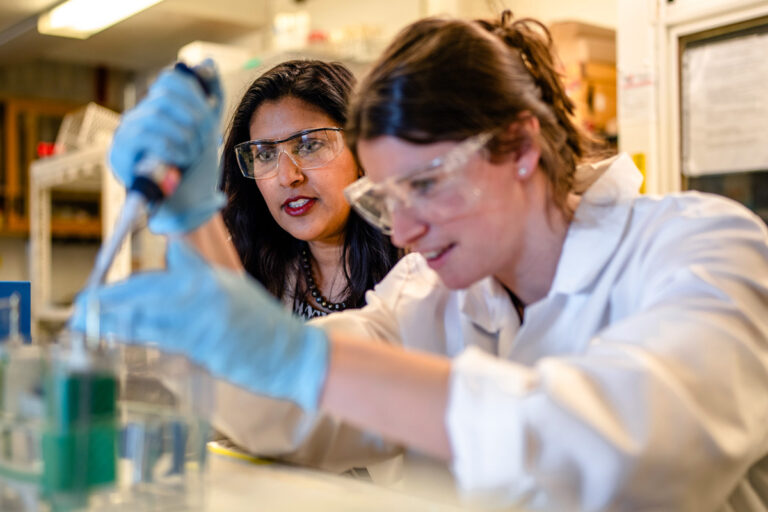By Katie Darragh, communication intern in the Office of University Relations at Marquette University

Seeing faculty members living alongside students on campus has not been the norm at Marquette, but for two professors, it was a natural next step toward developing deeper relationships with the Marquette University community.
Dr. Heidi Bostic, dean of the Helen Way Klingler College of Arts and Sciences and College of Education, and Stephen Pluháček, affiliated faculty member in theology, recently moved into an apartment in Campus Town East. The married couple are the first faculty to participate in Marquette’s new Faculty in Residence program, which the Office of Residence Life hopes will give faculty participants a clear on-campus presence to help foster a more holistic student experience at Marquette.
The program has four main goals:
- Student success: Research demonstrates Faculty in Residence has a positive impact on student success by improving recruitment, retention and successful transition into life after graduation.
- Employee engagement: Beyond encouraging faculty to live on campus, Faculty in Residence engage faculty and staff with the campus community and promote a positive workplace experience.
- Sustainability: Faculty in Residence places more faculty and staff within walking or biking distance to campus and promotes sustainability and integral ecology.
- Community relations: An increase of on-campus faculty and staff promotes engagement with the broader community, fosters safety and contributes to more thriving neighborhoods.
While living on campus may seem burdensome for two faculty members, Bostic and Pluháček see it as a positive step for professors looking to “walk the walk” at Marquette, Bostic says.
“We would not be doing it if it were an additional full-time job,” she says. “I think the spirit [of the program] is faculty integration with students and the community, which is an application of work we are already doing.”
In fact, for Bostic, the transition is “really natural as a dean because my goals as part of being a faculty in residence are the same: promoting the success of students, helping them connect with faculty, helping community relationships and building sustainability.”

Breaking down barriers by moving next door
For Pluháček, the Faculty in Residence program is an excellent way to break down barriers between students and faculty that could prevent learning and growth.
From a faculty perspective, he says, “Faculty have so much to learn from the students. If you’re only interacting in a very formal setting, then you are cut off from the kind of learning that you can get from just interacting with people.”
Reflecting on their own undergraduate experiences, Bostic and Pluháček note that the connections most transformative to them took place outside of the classroom.
“We have been thinking so much on the academic side about how to foster student success. We’ve reflected on how our relationships with professors made our undergraduate experience really meaningful,” Bostic says. “We had a lot of interactions with professors outside of the classroom. Therefore, we are seeking a way to make ourselves more available to students in an easy, low-barrier context.”

‘A different kind of energy’
It is no secret that living next to college students looks different than living next to neighbors in a typical apartment building. For Bostic and Pluháček, though, the student energy is a gift.
Pluháček says the commotion of students moving back into the apartments and seeing their friends reminds him of what it was like to come back to school.
“There is so much energy that comes from being around students. We don’t have kids. Our house is very quiet, but you get a different kind of energy living in a neighborhood with a lot of young people,” Bostic says.
Living next to students also has brought unexpected opportunities for the couple, such as attending on-campus speaker events, noon Mass or athletic events.
This experience has also been an opportunity for Pluháček to build his music collection from conversations with students in the elevator, and Bostic has found herself connecting with colleagues she does not normally have a chance to run into.
Overall, Bostic and Pluháček describe moving into Campus Town East like coming home.
Seeking student input
Mary Janz, director of residence life, Bostic and Pluháček are seeking student input to further develop the Faculty in Residence program.
“The next steps are about finding what students need and building on that. We are not trying to duplicate a program that is already in process,” Bostic says.
They recognize the program needs to develop organically, and it cannot be too constrained to be successful. Rather, they want student opinions, ideas and questions and will measure the success of the program by how well they were able to be a resource.
“We will know that this pilot program is successful when students feel comfortable enough to approach us without us asking,” Pluháček says. “It would be someone knocking on the door and saying they are missing something from home and us being able to provide them with that. We want to be a resource to students.”
If students have questions about the program or ideas for how students can benefit from the Faculty in Residence program, they are encouraged to email Janz, Bostic or Pluháček, or simply knock on their door.


